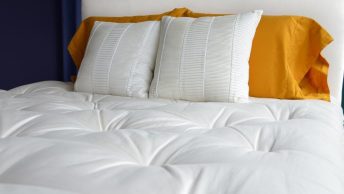Dry, stuffy air can cause a variety of problems, from irritated skin to sinus congestion. A simple solution to combating dry air is using a humidifier, which adds moisture back into the air. To get the most out of your humidifier and truly improve your home’s air quality, you’ll want to consider where you should place it in each room.
1. Bedroom
Your bedroom should be the first place to put a humidifier, as it’s where you spend the most time in your home and have your best chance at catching quality sleep. Place the unit on a nightstand or other elevated surface near your bed for optimal results. Having a humidifier run during the night when you sleep has a multitude of benefits including reducing snoring, congestion, and dry skin. Additionally, since most people spend up to 8 hours in their bedrooms, putting the humidifier close to where you sleep will help ensure maximum benefit.
2. Living Room
Another great place to position a humidifier is your living room. The area can be especially dry during the colder seasons, making it important to set up a unit in order to stay comfortable. To quickly freshen up air quality, place your humidifier near where you spend the most time in this room – like the couch or armchair. When you lay back to watch your favorite show, the humidity given off by your humidifier will help you relax and breathe easier.
3. Bathroom
Another area of your home that can become exceptionally dry is your bathroom, which is why it’s important to keep a humidifier in here as well. Since steam from showers and baths can help increase humidity levels, set up the unit near the entrance so air has time to circulate around the room. To keep your bathroom feeling and smelling fresh and clean, try humidifiers with essential oils such as eucalyptus or lavender.
4. Hallway
Positioning a humidifier in your hallway is beneficial for the air quality of other rooms, as it gives air a chance to circulate from one area to the next. Place it midway down the hall so it’s able to spread moisture throughout multiple areas of your home.
5. The Kitchen
The kitchen is a bustling area of the home and can become dry during meal prep. Since humidity levels are important for keeping food fresh, consider adding a unit to this room. Place your humidifier near the stove or oven to ensure air circulates around the entire space.
6. Home Office
If you work from home or spend time in your home office, consider adding a humidifier here to keep air fresh and comfortable while focusing. Place the unit near your desk or seating area for optimal performance. Having fresh, clean air in your office can help you stay productive and focused on the task at hand.
7. Basement
If your basement often feels stuffy and stale, a humidifier can help improve this in no time. Since basements are typically colder than other rooms in the home, consider adding a unit near your seating area or on a shelf. If you basement has lower air quality or lower circulation, you may want to consider an evaporative humidifier which is designed to work in these conditions.
8. Nursery
Babies and toddlers tend to be more sensitive to air quality, so it’s important to make sure their bedroom is properly humidified. Place the humidifier on an elevated surface like a dresser or nightstand. Set the level of the humidifier to the ideal humidity for a nursery or children’s room, which is around 40-50%. More than that and the room could end up feeling too damp and uncomfortable.
9. Playroom
If you have young kids, it’s important to add a humidifier in their playroom as well. Place the unit near where your child spends most time in the room so air is properly circulated throughout space. However, make sure that the unit is out of reach for safety purposes.
10. Garages
Humidifying a garage is often overlooked but can be extremely beneficial. If you often find your car’s windows fogging up or other signs of moisture, a unit may help to keep the area less damp. If you use your garage to work out, a humidifier can make it much more comfortable and help you breathe better during strenuous activities.
11. Greenhouse
For avid gardeners and plant lovers, adding a humidifier to your greenhouse that can help to keep air quality balanced for your plants. Place the unit near the entrance for optimal results.
Conclusion
These are just some of the essential places to put a humidifier that can help improve air quality in your home. Knowing where and how to position each unit is key for maximizing its performance and improving your indoor environment. With proper placement, you’ll be on your way to breathing easy in no time.







